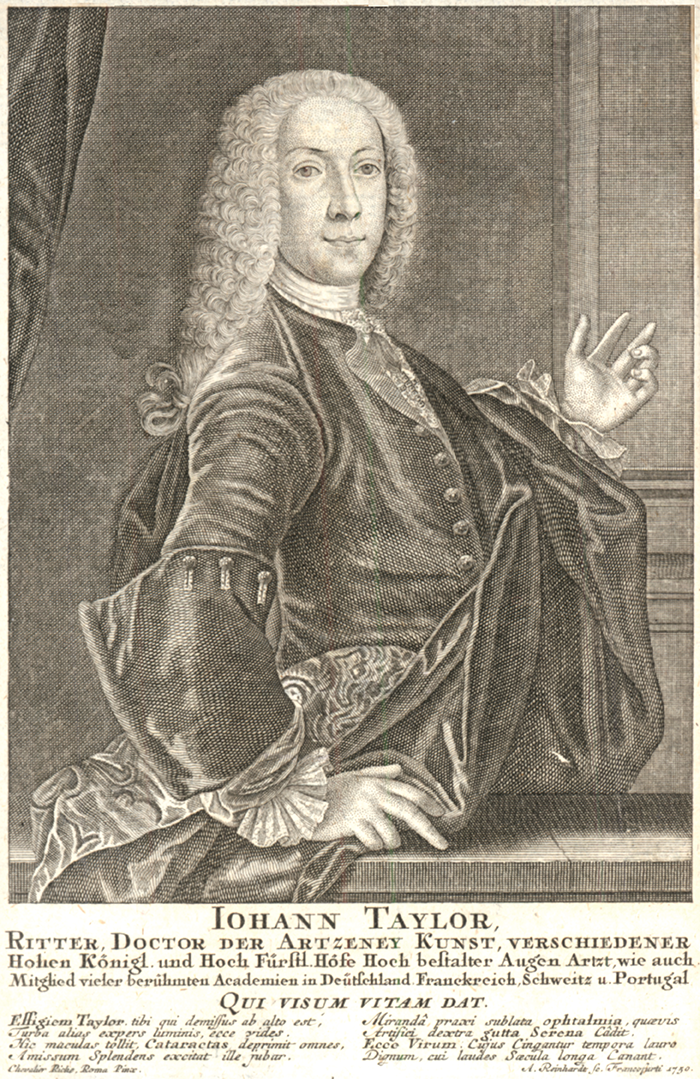
Image supplied by Christopher T. Leffler
Before about 1800, the practice of ophthalmology in Europe and in the New World looked very different than it does today. Most ophthalmologists (then called oculists) received informal apprenticeship-style training – and many practiced as itinerant surgeons. Perhaps one of the most famous – and certainly the most colorful – was English “Chevalier” John Taylor (1703–1772).
Taylor was described as “a tall, handsome man, and a great favorite with the ladies. He was much addicted to splendor in dress, and to an expensive style of domestic expenditure” (1). He trained under oculists William Cheselden in England and probably Edward Green the Younger in Scotland (2). He received medical degrees from Basel, Reims, and Cologne, although these have been dismissed as “honorary foreign degrees” (3). He claimed to hold a faculty position in Avignon, which was disputed (4). He used the self-conferred title “Chevalier,” French for “knight” (comparable to “Caballero” in Spanish, “Cavaliere” in Italian, or “Ritter” in German).
Taylor was appointed Royal Oculist to King George II in 1736, but spent decades traveling Europe. He was credited with many successful surgeries (presumably couchings), documented by patient testimonials and eyewitness accounts. However, Taylor was repeatedly accused of poor outcomes and fraudulent treatments, including sham strabismus surgeries. Most famously, he is reported to have operated on the composer Johann Sebastian Bach in Leipzig in 1750, although details of the procedure are unknown. Bach did not recover his vision and died of a stroke shortly thereafter. Taylor repeatedly found himself in political trouble, such as in 1769, when he was given “consilium abeundi” (advice to leave) from Prague and was forbidden to perform eye surgery within all Habsburg-controlled territories (5).
Taylor’s writings suggest anatomical knowledge at least as good as, and in some cases much better than, that of his contemporaries. He wrote in 1735, “All Cataracts are from an Alteration of the chrystalline Humour itself” (6) which represents a relatively “modern” understanding of the cataract as an opacified crystalline lens rather than, as was traditionally taught, a separate opacity anterior to the lens. Taylor published the first illustration of the semi decussation of the optic nerves through the chiasm in 1738 (7) and what appears to be the first ophthalmic atlas in 1766 (8).
Details concerning Taylor’s death are scarce. His grandson wrote, “After many years absence from this country, my grandfather’s death was noticed in the following manner in a continental paper: ‘Having given sight to many thousands, the celebrated Chevalier Taylor lately died blind, at a very advanced age; in a convent at Prague’” (1).
Taylor’s legacy is decidedly mixed. Perhaps he is best summarized by a contemporary, the Oxford Professor William King: “He seems to have understood the anatomy of the eye perfectly well; he has a fine hand and good instruments, and performs all his operations with great dexterity; for the rest, Ellum homo confidens! [Look, there is a confident man!] who undertakes any thing (even impossible cases) and promises every thing. No charlatan ever appeared with fitter and more excellent talents, or to a greater advantage” (9).
References
- J Taylor III, Records of My Life, Vol. 1, Edward Bull: 1832.
- CT Leffler et al., “The first cataract surgeons in the British Isles,” Am J Ophthalmol, 230, 75 (2021).
- S Wood, “A rare manuscript of Chevalier Taylor, the Royal Oculist, with notes on his life,” Br J Ophthalmol,14, 193 (1930).
- F Morénas, “Par ordre de mes Superieurs, je suis obligé de me retracter & de me dédire de ce que imprudemment & sur la simple assertion du Sr. Taylor Oculiste Anglois, j‘annoncai dans la Feüille precedente …” Courrier d‘Avignon, August 4, 1734.
- J Groß, “Der renommierte Windbeutel, Chevallier Taylor, ist bey seinem letzten Creuzzug der Staar gut gestochen worden,” Erlangische Real-Zeitung, July 7, 1769.
- Anon, “This Day is Published,” General Evening Post (London, England), 348 (1735).
- J Taylor, Mechanismus oder Neue Abhandlung : von der künstlichen Zusammensezung des menschlichen Auges und den besondern Nuzen desselben, sowohl vor sich, als in Absicht der anliegenden Theile, nebst seiner Art, dessen Krankheiten zu heilen, Wie Ersolche bey einer mehr als zwanzigjährigen Erfahrung seiner durch Europa glüklich gethanen Augencuren bewährt befunden, Erben und Schilling: 1738.
- J Taylor, Nova nosographia ophthalmica; hoc est accurata receniso ducentorum et quadraginta trium affectuum, qui oculum humanum partesque vicinas ullo modo laedere aut ipsum visum adimere posssunt, Grund & Holle: 1748.
- W King, Political and Literary Anecdotes of His Own Times, Wells and Lilly: 1819
